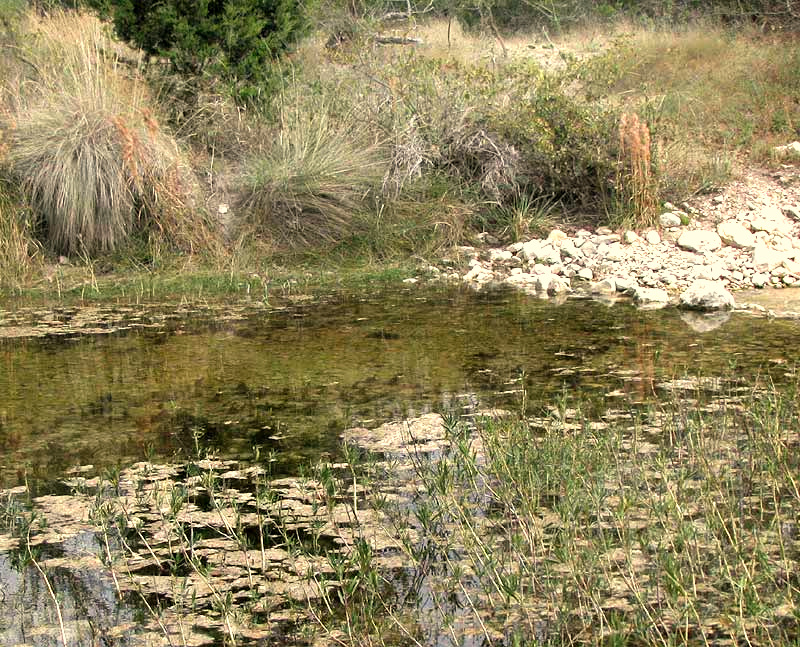Excerpts from Jim Conrad's
Naturalist Newsletter

from the November 18, 2012 Newsletter issued from the valley of the Dry Frio River in northern Uvalde County, southwestern Texas, on the southern border of the Edwards Plateau; elevation ~1750m (~5750 ft); N29.62°, W99.86°; USA
SCUM IN A POOL OF WATER
It's been awhile since it rained here so large cracks are opening in the ground, and the little Dry Frio River is down to just a trickle, in some places disappearing altogether as its waters seep downstream beneath gravel bars and fields of cobbles. Here and there pools have formed, like little ponds, and lately I've been noticing a certain scum gathering in bunches atop the water. You can see what I mean above.
Up close you see that very fine, hairlike filaments -- which from the first I assumed to be a kind of alga -- arise from the underwater stems of aquatic plants. The scum atop the water is mostly composed of bubbles, which one guesses to be filled with the oxygen the filaments photosynthesize during the day. You can see the submerged, hairlike, reddish filaments beneath some floating scum below:

We have a microscope here so I wondered if I could identify what kind of alga this was. A couple of filaments under high magnification are shown below:

I couldn't match our photograph with anything found on the Internet by doing an image search on the keywords "filamentous alga species." However, some features we can see very clearly narrow down the possibilities considerably.
First, our specimen is indeed filamentous. Many alga species live as freely floating single cells, or their cells are connected in some manner other than end-to-end like ours, forming a filament.
Second, our filament is non-branching, while certain other common types are highly branched.
Finally, you can see that the cells are shorter than they are broad. It's much more typical for the cells of filamentous algae to be considerably longer than broad, so this is a good field mark.
The only genus of filamentous algae I could find with these features is one sometimes called Hair Alga, genus ULOTHRIX. Ulothrix is one of the more common filamentous algae in ponds, streams and rivers, and it's easy to find pictures of it forming scum, just like ours. However, none of the species I saw had cellular structure exactly like ours, plus all references I found to Ulothrix indicated that it is bright green. You have seen that our scum-maker definitely shows a reddish hue.
After a great deal of Internetting, comparing pictures, and learning how outdated much of my understanding about the world of algae and algae-like things is, I've come to these understandings about our scum:
Probably the thing we're seeing used to be thought of as an alga -- one of the blue-green group -- but now it's classified as a cyanobacterium. There's a good chance that it the genus Oscillatoria. It's been hard for me to think of bacteria as producing alga-like filaments easily visible with the eye, but that seems to be the reality of things.
To give you an idea of how poorly understood yet how important this group of organisms is, consider this: The tiny marine cyanobacterium Prochlorococcus was discovered only in 1986, yet it accounts for more than half of the photosynthesis that takes place in the open ocean. And scientists believe that the ocean's phytoplankton contribute between 50 to 85 percent of the oxygen in Earth's total atmosphere. Therefore, a very substantial part of the oxygen you and I are breathing right now has been provided to us by cyanobacteria.
Praise be to the producer of those little bubbles in the scum down on the surface of the Dry Frio River behind the cabin.